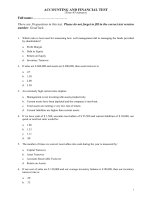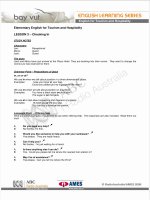SOLIDARITY AND POLITENESS
Bạn đang xem bản rút gọn của tài liệu. Xem và tải ngay bản đầy đủ của tài liệu tại đây (2.15 MB, 29 trang )
SOLIDARITY AND POLITENESS
Group members:
Hoàn Mỹ - Tường Vy – Phương Quyên
TU and VOUS
•
•
•
This distinction began as a difference between plural and singular.
‘Tu’ is used as ‘singular you’.
‘Vous’ is used as both ‘singular you’ (in certain occasions) and ‘plural
you’.
•
•
IV century: the use of plural vous was to address the emperor. There were two
emperors: one in Constantinople and another in Rome, but the Empire was
administratively unified. By addressing one, you were in fact addressing both emperors.
As a consequence, the medieval upper classes began to use V-forms among them to
show mutual respect and politeness.
‘Tu’ should be used between:
- Spouses.
- Close friends.
- Family member.
- Close relatives.
- Young people living or working closely together.
‘Tu’ shows the closeness, informality and solidarity.
Ex: Claire, tu es ma meilleure amie.
(Claire, you are my best friend.)
Ex: Papa, est-ce que tu peux m’aider.
(Dad, can you help me?)
•
‘Vous’ should be used between:
- Strangers.
- Older person.
- Authority figure.
- Those who have no ties any kind.
- Anyone to whom you wish to respect.
‘Vous’ shows respect, maintain a distance or formality with someone.
Ex: Monsieur, pourriez-vous me dire où se trouve la gare?
(Sir, could you tell me where the train station is?)
Ex: Madame, voici le rapport que vous avez demandé.
(Madam, here is the report you asked for.)
TU and VOUS
•
“Vous” is also the “plural you”.
•
“Vous” is used when talking to more than 1 person, no matter how
formal or informal you need to be.
Ex: Les enfants, vous êtes tous bien agités ce soir.
(Kids, you are all very fidgety tonight)
Ex: Mesdames, désirez-vous du café?
(Ladies, would you like some coffee)
SUMMARIZE
INFORMAL
FORMAL
1 PERSON
TU
VOUS
MORE THAN 1 PERSON
VOUS
VOUS
BE CAREFUL !!!
•
Someone in authority may address you as “tu” but that does not mean you
can response with “tu”
•
Example:
1. A teacher may address a student as “tu”, but the student should address the
teacher as “vous”.
2. An adult may address a child as “tu”, but the child should address the adult as
“vous” (Unless it’s a relative or someone close).
TU and VOUS
•
In some situation, if you’re not sure whether to use “tu” or “vous”,
it’s safer to start by using “vous”.
TU and VOUS
•
Mutual T for solidarity gradually replaced mutual V for politeness.
•
Use of asymmetrical T/V decreased and mutual V was often used in its place.
•
But…once a pair of speakers decide on mutual T, it is impossible to go back to
either T/V or V/V usage.
ADDRESS TERMS
How do you address or name people?
By title (T)? By first name (FN)? By last name (LN)? By nickname? By
some combination of these?
ADDRESS TERMS
•
•
•
Asymmetric use of title, last name and first name(TLN/FN) indicated inequality in power.
Mutual title, last name (TLN) indicated inequality and unfamiliarity.
Mutual first name (FN) indicated equality and familiarity.
ADDRESS TERMS
•
The switch from mutual TLN to FN is usually initiated by the most powerful member
in the relationship.
•
Address somebody by title is the least intimate form of address in that titles usually
designates ranks or occupations.
•
Using another’s first name is a sign of considerable intimacy.
ADDRESS TERMS
The Address Process Is Symmetrical Or Asymmetrical?
•
•
Asymmetric use of names and address terms is often a clear indictor of a power differential.
Examples:
+ Children and teachers.
+ In the past, white people addressing black people.
+ People addressing the Queen or the President.
ADDRESS TERMS
In each country there are different rules stating how people should address each other.
Example:
In England, we can omit the address term when greeting someone
In France, that avoidance could be impolite.
Bonjour
Bonjour, Monsieur
ADDRESS TERMS
As your family relationships change, issues of naming and addressing may arise.
Example:
How do you address your father/mother in law?
People sometimes give names to, and address
Example:
non – human as well as humans.
How do you address your pets, if you have?
Sumarize
•
The term of address indicates any lingustic form used by speakers to refer to the person
they are talking to.
•
•
The conditions for choosing address term change socially.
Asymmetric use of names and address terms is often a clear indictor of a power
differential.
POLITENESS
•
POLITENESS is socially prescribed, we adjust to others in social relationships in ways
society deems appropriate.
•
IMPOLITENESS depends on the existence of standards.
There are 2 kinds of Politeness:
Positive
•
We try to achieve solidarity and treat others as friends. We do not impose
and never threaten their face.
•
Example: symmetrical pronominal use.
Negative
•
•
It leads to deference, indirectness and formality in language use.
Example: Asymmetric T/V use.









